Journal articles by Mariano Ramirez

Journal of Developing Societies, 2024
This article presents a case study of the application of human-centered design (HCD) as a codesig... more This article presents a case study of the application of human-centered design (HCD) as a codesign approach to address complex problems in slum communities in Jakarta, Indonesia. Through a review of relevant literature, we examine how the HCD methodology embraces a participatory framework but retains a certain degree of control not found in pure participatory approaches. We explain why HCD was selected for this study and describe the methods used, including sort cards, solution cards, in-depth interviews, focus group discussions, and product usability interviews. These methods were employed to generate a solution that addressed the issue of sourcing clean water in Jakarta’s slums, which was then prototyped, tested, and implemented. The study contributes to the development of a cohesive and applicable methodology by integrating codesign and HCD in designing solutions for people at the Base of the Pyramid.
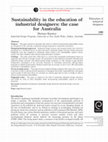
International Journal of Sustainability in Higher Education, 2006
Purpose -The paper intends to determine the extent to which environmental sustainability issues a... more Purpose -The paper intends to determine the extent to which environmental sustainability issues are integrated in the curricula of industrial design programs in Australian universities. Design/methodology/approach -Industrial design lecturers and program heads were invited to participate in a web-based survey on their university's industrial design curricula. Online university handbooks were also examined to determine which courses cover sustainability aspects. Survey results were then tabulated and analysed using descriptive statistics. Findings -The study shows that, while there is a concern that sustainable development issues are important and relevant to design courses, the permeation of environmental sensitivity through most industrial design curricula, and indeed among design academics, is only starting to gain ground. Comparative examination of the curricular structures in Australian universities offering degree programs in industrial and product design revealed that, on average, 12 out of every 100 credit points earned have sustainability content. Practical implications -The paper informs industrial design academics that much more work has to be done in order to educate the next generation of designers about their responsibilities to the planet and its people. It tells them where we currently are and the gaps that we have to bridge in order to achieve environmental sustainability. Originality/value -The paper is original in the field of Australian industrial design education, and builds on work in other disciplines about incorporating sustainability aspects in tertiary education.

She Ji: The Journal of Design, Economics, and Innovation, 2021
Current production and consumption patterns are unsustainable, causing irreversible damage to the... more Current production and consumption patterns are unsustainable, causing irreversible damage to the environment and human health and well-being. Designers play a vital role in resolving this problem-their decisions affect product manufacturing, distribution, use, and disposal-and hence they must be aware of the positive and negative impacts of their design decisions. Sustainable product design education is key to developing the knowledge, skills, and responsibility required for future generations of product designers and their educators to make informed and responsible decisions within their practice, and also enhance the social and environmental performance of their creations and effectively communicate the value of such decisions within a commercial context. In this article, we present insights and challenges in contemporary sustainable product design education in higher education. We document the experiences of six academics involved in teaching and researching sustainable product design in the United Kingdom, Australia, Denmark, the Netherlands, and the United States. We hope to provide a useful reference for academics seeking to adopt sustainable product design practices in their existing programs, develop new sustainable product design education programs, or reflect on their own existing product design practice.
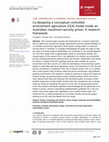
Cogent Social Sciences, 2023
This research paper presents the framework for a research study that aims to define and evaluate ... more This research paper presents the framework for a research study that aims to define and evaluate the design requirements and the related feasibility of a controlled environment agriculture (CEA) system concept within a maximum-security prison in Australia. A co-design methodology will guide the study so that the views of a broad range of stakeholders can contribute to the conceptualization of a CEA farm system that is appropriately suited to correctional settings. The unique aspect of this research lies in the application of a bottom-up consultative process involving both prison administrators and inmates. Stakeholders will initially be asked to consider what CEA typology would be most suitable for a prison environment and then use this as a basis for developing a more extensive system design. As open-field agriculture represents a lower-cost alternative to CEA, this will also be considered to complement CEA. The co-design sessions will run in tandem with current growth trials of lettuce within the prison environment using different growing environments. The research is aimed at assisting to reduce the impacts of climate change, by growing produce locally. Growing produce within the prison walls reduces food miles and improves the nutritional quality of produce, which benefits longer-term inmate health. Growth trials that complement the co-design study are aimed at evaluating the ease of use for each of type growing environment. This research contributes significant new knowledge for the application of co-design in prisons, aimed at developing implementation guidelines for a CEA ecosystem that would supply fresh vegetables to pre-cooked inmate meals. The researcher has a unique perspective as an inmate. Outside community groups wishing to try CEA may also benefit from this study.
Design Studies, 2009
In the product development process, cultural influences arguably come into play, such that the co... more In the product development process, cultural influences arguably come into play, such that the concepts created by industrial designers are partly shaped by the designers' own cultural and societal values. This study investigates the integration of the cultural ...
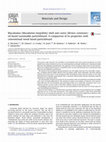
Materials & Design, 2013
ABSTRACT The present study examines the suitability of particleboard made from ground macadamia n... more ABSTRACT The present study examines the suitability of particleboard made from ground macadamia nut shells bonded with castor oil derived resin as an environmentally sustainable substitute for conventional wood fiber/urea formaldehyde particleboards. The properties of the macadamia shell castor oil resin particleboard were compared with those of a wood fiber/castor oil resin particleboard and a conventional wood fiber/urea formaldehyde particleboard.The density of the macadamia shell particleboard was 43% higher than that of its wood fiber counterpart, in keeping with the higher density of the macadamia shells. Water absorption and water-induced swelling were much lower in the macadamia shell particleboard, being only one quarter of the value obtained for the wood fiber particleboard. This is consistent with the lower moisture absorption reported previously for macadamia shells.The internal bond strength was similar for the macadamia shell and wood fiber particleboards bonded with castor oil based polyurethane. The modulus of rupture and modulus of elasticity were however about 50% lower for the macadamia shell particleboard than for its wood fiber counterpart. This is considered to be due, at least in part, to the lower cellulose content of macadamia shells.Formaldehyde emissions from the castor oil resin particleboards were less than 5% of those typical of urea formaldehyde particleboards.Based on these findings it is considered that macadamia shell/castor oil particleboards have acceptable properties for use in the built environment. Their good moisture resistance makes them particularly attractive for use in humid environments, such as in bathroom and kitchen applications. Moreover, they have much lower environmental impact than conventional particleboards.

MIX Sustentável, 2022
This paper proposes a new comprehensive Design for Sustainability (DfS) tool, called Design for A... more This paper proposes a new comprehensive Design for Sustainability (DfS) tool, called Design for Amelioration, with which designers can assess the sustainability level of all pillars of sustainability: people, planet, and profit, at every stage of the design process. DfS tools are used adjacent to the Human-Centered Design (HCD) process to determine the sustainability level of the proposed solution; be it a product, service, or a combination of both. HCD process is mainly chosen due to its focus on the people pillar of sustainability which is often overlooked in DfS tools. Thirty different types of DfS tools are cataloged and compared and the findings show that the majority of them are underdeveloped while others are still in a theoretical stage. The underperformed ones in one or two pillars of sustainability, thus, can only be categorized as partial DfS tools. These tools are then fitted into the known HCD’s framework of inspiration, ideation, and implementation. While many tools are suitable to be used in one particular stage of a design process, analysis shows that only a small number of them are comprehensive enough to be used throughout the entirety of the design process.
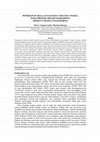
Spektrum Industri, 2018
Pengajaran desain produk industri yang berbasis keberlanjutan (sustainable product design) adalah... more Pengajaran desain produk industri yang berbasis keberlanjutan (sustainable product design) adalah aspek pendidikan desain produk industri yang penting dalam pendidikan desain pada umumnya saat ini. Penelitian ini ditujukan untuk memberi pemahaman lebih lanjut mengenai desain produk industri yang berkelanjutan dalam lingkup perguruan tinggi dengan menerapkan metode Okala pada proyek desain mahasiswa Product Design Engineering untuk memperoleh desain-desain yang berkelanjutan dan yang lebih berwawasan lingkungan. Okala Eco-Design Strategy Wheel merupakan metode life cycle assessment yang memberikan pandangan lebih luas bagi desainer produk industri untuk sehingga dapat memperkirakan dampak yang mungkin terjadi dalam masa hidup sebuah produk mulai dari pembuatan hingga saat produk tersebut habis masa pakai/siklus hidupnya. Hasil penelitian ini menunjukkan bahwa metodologi Okala dapat secara cepat dipahami dan dengan waktu yang cukup singkat diterapkan oleh mahasiswa pada proyek desain mereka. Dengan demikian, dalam garis besarnya, metode Okala dinilai dapat memberikan pemahaman lebih kepada mahasiswa khususnya terkait dengan topik desain produk industri yang berkelanjutan.
Book chapters by Mariano Ramirez

The imperative to teach future generations of industrial designers about the ecological and socia... more The imperative to teach future generations of industrial designers about the ecological and social sustainability aspects of their practice needs no argument. The profession has generally been blamed for promoting conspicuous consumption and stylistic obsolescence, and designers are considered indirectly responsible for the masses of discarded and short-lived objects in landfill. This paper examines how industrial design education is making up for past errors in design practice. It looks at the undergraduate and postgraduate programs of industrial design universities in various countries around the world, searching for evidences of both ecologically and socially sustainable design in the program descriptions, teaching and learning modules, and galleries of student works appearing on university websites. This research will be useful for industrial design course leaders and academics who are interested in benchmarking the extent to which they cover sustainability in their educational programs, and help them gauge how they fare in educating their students to become more responsible practitioners in the future.
World Sustainability Series, 2014
By the act of signing the Talloires Declaration, university presidents and chancellors worldwide ... more By the act of signing the Talloires Declaration, university presidents and chancellors worldwide committed themselves to educate young people towards being more sustainability focused, with a lofty ambition to change the world for the better. A good number of these higher education institutions offer degrees in industrial design, a career which has often been implicated for its sizable contributions to the mountains of short-lived products and packages in landfills around the world. This paper investigates whether the promises made in this declaration are permeating in the education of industrial designers in signatory universities. It looks into the curricula and student portfolios of industrial design degrees and uses content analysis to understand how sustainability thinking is integrated into product design pedagogy.
Conference papers by Mariano Ramirez

Designing Sustainability for All: Proceedings of the LeNS World Distributed Conference, 2019
Considered innovative and radical due to the way they disrupt consumerist lifestyles, 'sustainabl... more Considered innovative and radical due to the way they disrupt consumerist lifestyles, 'sustainable product service systems' (s.PSS) can reduce the negative environmental impacts from wasteful consumption. An inventory of existing s.PSS solutions in Oceania was carried out to help inspire entrepreneurs and innovators to champion alternative ways of needs fulfilment and to offer added value to customers with less ecological damage. The search encompassed cases of collaborative consumption lifestyles, redistribution markets, distributed production, and the circular economy. Over 140 innovative cases were found. Analysis showed that the majority of cases found were use-oriented PSS, such as product sharing, renting, leasing or pooling, and there were hardly any innovative cases of product-and result-oriented PSS. While many of the PSS cases in the study demonstrated environmental improvement through minimized resources and waste, others in fact were more material and energy intensive and therefore negated the sustainability advantage.
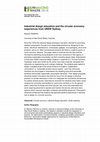
Unmaking Waste, 2018
Since the 1970s the industrial design profession has been criticized for promoting wasteful consu... more Since the 1970s the industrial design profession has been criticized for promoting wasteful consumption through such irresponsible practices as 'designing for the dump', fad-driven obsolescence, unnecessary gadgets, over-packaging, short-lived products, and so on. Most manufactured products still follow a 'cradle-to-grave' or 'linear-economy' lifecycle. This paper seeks to examine how the tide could be reversed by educating young designers to be more conscious of their agency in promoting sustainable consumption via their innovative design ideas. Submissions of third year UNSW Industrial Design students in response to a 'Circular Economy Challenge' studio brief written by the author have been analyzed, alongside their reflections on experiencing such a design challenge. The students were tasked to design a tangible product that would enhance or enable a 'collaborative consumption' or 'sustainable product service system', such that community members are encouraged or empowered into adopting more environmentally beneficial and socially responsible consumption behaviors. Their design proposals should be system innovations that shift the focus from the design of physical products for private ownership to that of an integrated mix of products and services for publicly shared access. Submissions received from students were highly varied, ranging from amenities and facilities for community members or for the general public; some free-of-charge and some pay-per-use; some fully-automated and some requiring personnel to operate and maintain the service; and some were systems which required returnable containers and refilling equipment. Post-project reflections evidenced that students had generally positive experiences in learning how to design for a circular economy.
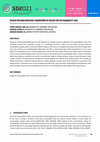
SDS2021 Simpósio de Design Sustentável
Design for Sustainability (DfS) tools are used adjacent to a design process to determine the sust... more Design for Sustainability (DfS) tools are used adjacent to a design process to determine the sustainability level of the proposed solution be it a product, service, or a combination of both. A DfS tool must assess all three pillars of sustainability: people, planet, and profit. Different types of DfS tools are cataloged and compared and the findings show that many of them are underdeveloped while others are still in a theoretical stage. Some underperform in one or two pillars of sustainability thus can only be categorized as partial DfS tools. These tools are then fitted into the framework of the human-centered design process due to its focus on the people pillar of sustainability which is often overlooked. While many tools are suitable to be used in one particular stage of a design process, analysis shows that only a small number of them are comprehensive enough to be used throughout the entirety of the design process. The versatility of different DfS tools is deemed essential because it allows designers to keep track of their projects at any point in the design process. A framework for a more comprehensive DfS tool is then proposed, called Design for Amelioration, with which designers assess the sustainability level of all pillars of sustainability at every stage of the design process.
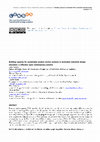
Sustainable energy for all by design: Proceedings of LeNSES2016 Conference of the Learning Network on Sustainable Energy Systems, 2016
Product service systems (PSS) have broadened sustainability agendas within industrial design (ID)... more Product service systems (PSS) have broadened sustainability agendas within industrial design (ID) education in Australia. In building PSS capacities for ID practice the relationships between need and use (service) and the mediating nature of tangible products and their attunement to cultural and contextual conditions get amplified. This article reflects on our work in accentuating the nature of ID in PSS through education. We discuss how we have adapted the original notion of PSS; retaining its principles but taking new approaches in the design of products that are central to a service proposition. A series of case studies of PSS in ID education from members of the LeNS Oceania network are conveyed to illustrate systemic concerns of design in product and service making. The authors describe a variety of ways in which PSS innovations have been framed and might be furthered within the Australian ID education context.
SDS2021 Simpósio de Design Sustentável
Recognizing that most design solutions are human-centered, this study focuses on the agency of de... more Recognizing that most design solutions are human-centered, this study focuses on the agency of design to serve the needs of other living things and the broader ecosphere. Promising examples of non-anthropocentric innovations in Australia were collected; 12 were selected and written as mini case studies, and then analyzed using the lens of Metcalfe's principles of Multispecies Design. The research concludes that designing practical innovations that have benefits for other species as well as for humans is possible and shows potential in meeting biodiversity goals.
SDS2021 Simpósio de Design Sustentável, 2021
Product service systems (PSS) have the potential to radically reduce the negative environmental i... more Product service systems (PSS) have the potential to radically reduce the negative environmental impacts of wasteful consumption. An inventory of existing solutions in the Philippines was carried out to inspire entrepreneurs and innovators with alternative ways of needs fulfillment that are less ownership-centric, and to offer new forms of added value to consumers via everyday solutions that can be more ecologically beneficial. The search encompassed cases of collaborative consumption lifestyles, redistribution markets, and the circular economy.
SDS2021 Simpósio de Design Sustentável
Responding to the lack of academic literature about sustainable services in convenience stores, t... more Responding to the lack of academic literature about sustainable services in convenience stores, this preliminary study explores the current situation for sustainable services and initiatives among convenience stores in Japan and Australia. More specifically, the paper explores the potentials for enabling collaborative consumption and product-service systems in convenience retailing spaces.

SDS2021 Simpósio de Design Sustentável, 2021
This paper aims to investigate how human-centered design (HCD), combined with participatory desig... more This paper aims to investigate how human-centered design (HCD), combined with participatory design methods, can address complex problems in communities such as the slums in Jakarta, Indonesia. Literature review points out that even though it embraces a participatory approach and employs some participatory methods, HCD is not purely participatory. This is because HCD allows designers (and researchers) a certain degree of control that would not be accommodated within a pure participatory approach. After establishing proper reasonings for choosing the HCD methodology, the methods of Card Sort, Solution Card, and In-depth Interviews were utilized to investigate the problems of the people living in slums in Jakarta, especially in the field of WASH: water, sanitation, and hygiene. Insights gathered suggest that most of the issues are closely related to low income and the lack of proper infrastructure in the community. Utilizing the methodology of HCD as well as encouraging participatory engagement in a context with such complex issues was proven to be essential in understanding the problems at hand and informing the creation of suitable solutions.

SDS2021 Simpósio de Design Sustentável, 2021
This paper presents the framework for an early-stage PhD research project that aims to define and... more This paper presents the framework for an early-stage PhD research project that aims to define and test the design requirements and the related feasibility of a Controlled Environment Agriculture (CEA) system concept within a maximum-security correctional center in Australia. The research seeks to develop new knowledge within the emerging field of CEA, drawing on the current understanding in the research literature and practice. Taking CEA technologies within the prison context creates new design challenges and opportunities that may lead to valuable knowledge relevant both within and outside prison systems. Situated within the industrial design discipline, the research and design process for developing the CEA system concept is an iterative, emergent process. The broad area in which this study is situated is in the field of CEA which can take the form of a vertical farm, where produce is grown vertically in warehouse-type shelves or on vertical panels. The unique aspect of this research lies in the application of a bottom-up consultative codesign process involving both prison administrators and inmate stakeholders. This project will contribute significant new knowledge using action research aimed at developing implementation guidelines for a CEA ecosystem that would supply fresh vegetables to inmates. Outside community groups may also benefit from this research.











Uploads
Journal articles by Mariano Ramirez
Book chapters by Mariano Ramirez
Conference papers by Mariano Ramirez